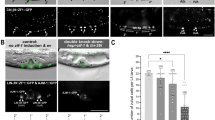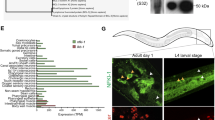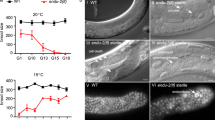Abstract
Vertebrate Tob/BTG proteins inhibit cell proliferation when overexpressed in tissue-culture cells, and they can function as tumor suppressors in mice. The single Caenorhabditis elegans Tob/BTG ortholog, FOG-3, by contrast, was identified from its loss-of-function phenotype as a regulator of sperm fate specification. Here we report that FOG-3 also regulates proliferation in the germline tissue. We first demonstrate that FOG-3 is a positive regulator of germline proliferation. Thus, fog-3 null mutants possess fewer germ cells than normal, a modest but reproducible decrease observed for each of two distinct fog-3 null alleles. A similar decrease also occurred in fog-3/+ heterozygotes, again for both fog-3 alleles, revealing a haplo-insufficient effect on proliferation. Therefore, FOG-3 normally promotes proliferation, and two copies of the fog-3 gene are required for this function. We next overexpressed FOG-3 by removal of FBF, the collective term for FBF-1 and FBF-2, two nearly identical PUF RNA-binding proteins. We find that overexpressed FOG-3 blocks proliferation in fbf-1 fbf-2 mutants; whereas germ cells stop dividing and instead differentiate in fbf-1 fbf-2 double mutants, they continue to proliferate in fog-3; fbf-1 fbf-2 triple mutants. Therefore, like its vertebrate Tob/BTG cousins, overexpressed FOG-3 is ‘antiproliferative’. Indeed, some fog-3; fbf-1 fbf-2 mutants possess small tumors, suggesting that FOG-3 can act as a tumor suppressor. Finally, we show that FOG-3 and FBF work together to promote tumor formation in animals carrying oncogenic Notch mutations. A similar effect was not observed when germline tumors were induced by manipulation of other regulators; therefore, this FOG-3 tumor-promoting effect is context dependent. We conclude that FOG-3 can either promote or inhibit proliferation in a manner that is sensitive to both genetic context and gene dosage. The discovery of these FOG-3 effects on proliferation has implications for our understanding of vertebrate Tob/BTG proteins and their influence on normal development and tumorigenesis.
This is a preview of subscription content, access via your institution
Access options
Subscribe to this journal
Receive 50 print issues and online access
$259.00 per year
only $5.18 per issue
Buy this article
- Purchase on Springer Link
- Instant access to full article PDF
Prices may be subject to local taxes which are calculated during checkout





Similar content being viewed by others
References
Jia S, Meng A . Tob genes in development and homeostasis. Dev Dyn 2007; 236: 913–921.
Mauxion F, Chen CY, Seraphin B, Shyu AB . BTG/TOB factors impact deadenylases. Trends Biochem Sci 2009; 34: 640–647.
Winkler GS . The mammalian anti-proliferative BTG/Tob protein family. J Cell Physiol 2010; 222: 66–72.
Yoneda M, Suzuki T, Nakamura T, Ajima R, Yoshida Y, Kakuta S et al. Deficiency of antiproliferative family protein Ana correlates with development of lung adenocarcinoma. Cancer sci 2008; 100: 225–232.
Yoshida Y, Nakamura T, Komoda M, Satoh H, Suzuki T, Tsuzuku JK et al. Mice lacking a transcriptional corepressor Tob are predisposed to cancer. Genes Dev 2003; 17: 1201–1206.
Farioli-Vecchioli S, Tanori M, Micheli L, Mancuso M, Leonardi L, Saran A et al. Inhibition of medulloblastoma tumorigenesis by the antiproliferative and pro-differentiative gene PC3. FASEB J 2007; 21: 2215–2225.
Yanagie H, Tanabe T, Sumimoto H, Sugiyama H, Matsuda S, Nonaka Y et al. Tumor growth suppression by adenovirus-mediated introduction of a cell-growth-suppressing gene tob in a pancreatic cancer model. Biomed pharmacother 2009; 63: 275–286.
Ficazzola MA, Fraiman M, Gitlin J, Woo K, Melamed J, Rubin MA et al. Antiproliferative B cell translocation gene 2 protein is down-regulated post-transcriptionally as an early event in prostate carcinogenesis. Carcinogenesis 2001; 22: 1271–1279.
Ito Y, Suzuki T, Yoshida H, Tomoda C, Uruno T, Takamura Y et al. Phosphorylation and inactivation of Tob contributes to the progression of papillary carcinoma of the thyroid. Cancer lett 2005; 220: 237–242.
Iwanaga K, Sueoka N, Sato A, Sakuragi T, Sakao Y, Tominaga M et al. Alteration of expression or phosphorylation status of tob, a novel tumor suppressor gene product, is an early event in lung cancer. Cancer lett 2003; 202: 71–79.
Kawakubo H, Brachtel E, Hayashida T, Yeo G, Kish J, Muzikansky A et al. Loss of B-cell translocation gene-2 in estrogen receptor-positive breast carcinoma is associated with tumor grade and overexpression of cyclin d1 protein. Cancer Res 2006; 66: 7075–7082.
Majid S, Dar AA, Ahmad AE, Hirata H, Kawakami K, Shahryari V et al. BTG3 tumor suppressor gene promoter demethylation, histone modification and cell cycle arrest by genistein in renal cancer. Carcinogenesis 2009; 30: 662–670.
Struckmann K, Schraml P, Simon R, Elmenhorst K, Mirlacher M, Kononen J et al. Impaired expression of the cell cycle regulator BTG2 is common in clear cell renal cell carcinoma. Cancer Res 2004; 64: 1632–1638.
Toyota M, Suzuki H, Sasaki Y, Maruyama R, Imai K, Shinomura Y et al. Epigenetic silencing of microRNA-34b/c and B-cell translocation gene 4 is associated with CpG island methylation in colorectal cancer. Cancer Res 2008; 68: 4123–4132.
Ellis RE, Kimble J . The fog-3 gene and regulation of cell fate in the germ line of Caenorhabditis elegans. Genetics 1995; 139: 561–577.
Chen P-J, Singal A, Kimble J, Ellis RE . A novel member of the Tob family of proteins controls sexual fate in Caenorhabditis elegans germ cells. Dev Biol 2000; 217: 77–90.
Kimble J, Crittenden SL . Controls of germline stem cells, entry into meiosis, and the sperm/oocyte decision in Caenorhabditis elegans. Annu Rev Cell Dev Biol 2007; 23: 405–433.
Zhang B, Gallegos M, Puoti A, Durkin E, Fields S, Kimble J et al. A conserved RNA-binding protein that regulates sexual fates in the C. elegans hermaphrodite germ line. Nature 1997; 390: 477–484.
Thompson BE, Bernstein DS, Bachorik JL, Petcherski AG, Wickens M, Kimble J . Dose-dependent control of proliferation and sperm specification by FOG-1/CPEB. Development 2005; 132: 3471–3481.
Kershner AM, Kimble J . Genome-wide analysis of mRNA targets for Caenorhabditis elegans FBF, a conserved stem cell regulator. Proc Natl Acad Sci USA 2010; 107: 3936–3941.
Crittenden SL, Bernstein DS, Bachorik JL, Thompson BE, Gallegos M, Petcherski AG et al. A conserved RNA-binding protein controls germline stem cells in Caenorhabditis elegans. Nature 2002; 417: 660–663.
Lamont LB, Kimble J . Developmental expression of FOG-1/CPEB protein and its control in the Caenorhabditis elegans hermaphrodite germ line. Dev Dyn 2007; 236: 871–879.
Lee M-H, Kim KW, Morgan CT, Morgan DE, Kimble J . Phosphorylation state of a Tob/BTG protein, FOG-3, regulates initiation and maintenance of the Caenorhabditis elegans sperm fate program. Proc Natl Acad Sci USA 2011; 108: 9125–9130.
Lamont LB, Crittenden SL, Bernstein D, Wickens M, Kimble J . FBF-1 and FBF-2 regulate the size of the mitotic region in the C. elegans germline. Dev Cell 2004; 7: 697–707.
Crittenden SL, Leonhard KA, Byrd DT, Kimble J . Cellular analyses of the mitotic region in the Caenorhabditis elegans adult germ line. Mol Biol Cell 2006; 17: 3051–3061.
Cinquin O, Crittenden SL, Morgan DE, Kimble J . Progression from a stem cell-like state to early differentiation in the C. elegans germ line. Proc Natl Acad Sci USA 2010; 107: 2048–2053.
Berry LW, Westlund B, Schedl T . Germ-line tumor formation caused by activation of glp-1, a Caenorhabditis elegans member of the Notch family of receptors. Development 1997; 124: 925–936.
Kadyk LC, Kimble J . Genetic regulation of entry into meiosis in Caenorhabditis elegans. Development 1998; 125: 1803–1813.
Rodier A, Rochard P, Berthet C, Rouault JP, Casas F, Daury L et al. Identification of functional domains involved in BTG1 cell localization. Oncogene 2001; 20: 2691–2703.
Kawamura-Tsuzuku J, Suzuki T, Yoshida Y, Yamamoto T . Nuclear localization of Tob is important for regulation of its antiproliferative activity. Oncogene 2004; 23: 6630–6638.
Byrd DT, Kimble J . Scratching the niche that controls Caenorhabditis elegans germline stem cells. Semin Cell Dev Biol 2009; 20: 1107–1113.
Busson M, Carazo A, Seyer P, Grandemange S, Casas F, Pessemesse L et al. Coactivation of nuclear receptors and myogenic factors induces the major BTG1 influence on muscle differentiation. Oncogene 2005; 24: 1698–1710.
Rodier A, Marchal-Victorion S, Rochard P, Casas F, Cassar-Malek I, Rouault JP et al. BTG1: a triiodothyronine target involved in the myogenic influence of the hormone. Exp Cell Res 1999; 249: 337–348.
el-Ghissassi F, Valsesia-Wittmann S, Falette N, Duriez C, Walden PD, Puisieux A . BTG2(TIS21/PC3) induces neuronal differentiation and prevents apoptosis of terminally differentiated PC12 cells. Oncogene 2002; 21: 6772–6778.
Barton MK, Schedl TB, Kimble J . Gain-of-function mutations of fem-3, a sex-determination gene in Caenorhabditis elegans. Genetics 1987; 115: 107–119.
Brenner S . The genetics of Caenorhabditis elegans. Genetics 1974; 77: 71–94.
Podbilewicz B . Cell fusion. In: The C. elegans Research Community (ed) WormBook. WormBook, Pasadena, CA, 2006.
Thompson BE, Lamont LB, Kimble J . Germ-line induction of the Caenorhabditis elegans vulva. Proc Natl Acad Sci USA 2006; 103: 620–625.
Guéhenneux F, Duret L, Callanan MB, Bouhas R, Hayette S, Berthet C et al. Cloning of the mouse BTG3 gene and definition of a new gene family (the BTG family) involved in the negative control of the cell cycle. Leukemia 1997; 11: 370–375.
Albrecht M, Lengauer T . Novel Sm-like proteins with long C-terminal tails and associated methyltransferases. FEBS Lett 2004; 569: 18–26.
Hendzel MJ, Wei Y, Mancini MA, Van Hooser A, Ranalli T, Brinkley BR et al. Mitosis-specific phosphorylation of histone H3 initiates primarily within pericentromeric heterochromatin during G2 and spreads in an ordered fashion coincident with mitotic chromosome condensation. Chromosoma 1997; 106: 348–360.
Acknowledgements
We thank the Japanese consortium for generation of fog-3(tm4376) and the CGC for strains. We also thank members of the Kimble lab for helpful discussions, Laura Vanderploeg for help with figures and Anne Helsley for help preparing the manuscript. JJS was supported by NIH Training Grant 5T32GM007215 in Molecular Biosciences. JK is supported by NIH R01GM069454. JV is supported by NIH 5F32GM095036. JK is an investigator of the Howard Hughes Medical Institute.
Author information
Authors and Affiliations
Corresponding author
Ethics declarations
Competing interests
The authors declare no conflict of interest.
Additional information
Supplementary Information accompanies the paper on the Oncogene website
Rights and permissions
About this article
Cite this article
Snow, J., Lee, MH., Verheyden, J. et al. C. elegans FOG-3/Tob can either promote or inhibit germline proliferation, depending on gene dosage and genetic context. Oncogene 32, 2614–2621 (2013). https://doi.org/10.1038/onc.2012.291
Received:
Revised:
Accepted:
Published:
Issue Date:
DOI: https://doi.org/10.1038/onc.2012.291



